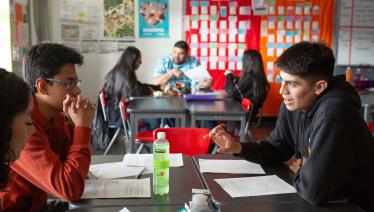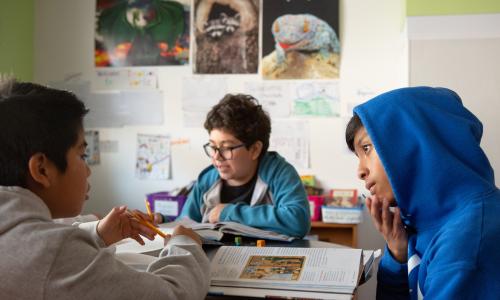Peer learning can be a powerful tool in the classroom, particularly for English language learners (ELLs). Encouraging peer interaction and collaboration not only provides opportunities for language use and practice — it builds community in the classroom! ELLs also benefit from observing how their peers learn and solve problems.
However, most students, especially ELLs, will need guidance and lots of practice with group work. This article offers some ideas you can use to get started.
Reflection Questions:
- What benefits have you seen from peer learning with students?
- How are some important considerations when planning peer activities for ELLs?
1. Give students lots of practice
Related research
Learn more about peer learning in Dr. Diane August's article "Educating English Language Learners" in American Educator.
Whenever you introduce new strategies that involve pair or group work, assign ELLs' roles carefully. Use modeling, clear directions, and comprehension checks to ensure students understand:
- how the activity works
- their role in group work
- the objective of the activity
- any key vocabulary or phrases they should be using.
Here are additional other tips on group work for ELLs that Judie Haynes and Debbie Zacarian share in their book Teaching English Language Learners Across the Content Areas:
- Assign students group roles that match their language ability (37).
- Promote students to new roles as their language skills improve (42).
- Make sure that all students understand that they will be working in diverse groups and that everyone's contributions are important (41).
- Keep an eye on the balance of student participation; if some students are speaking more than others, ask them to think of some ways to even participation out (42).
- Ask students to reflect on their group work after they have finished an activity. Haynes and Zacarian include a chart in their book with some guiding statements for student reflection (48).
Increasing ELLs' comfort with group work
- Give students lots of opportunities to express themselves and practice discussion in smalls group and the larger group. Small groups may be especially beneficial for ELLs.
- Keep in mind that some ELLs may be apprehensive about speaking out in a group and afraid to make mistakes in front of their peers.
- In addition, keep in mind that ELLs may be trying to use English with their English-speaking peers but their peers may not be engaging with them. This was a common occurence that Dr. Diane August noticed in her research into ELLs' peer learning.
- Stay positive and patient with your ELLs, and remind other students to do the same.
- If needed, use some activities to build empathy and respect for ELLs, such as talking about the benefits of being bilingual, asking students to teach their peers a few words in their language, or asking a bilingual teacher to teach a lesson in another language to the class for a few minutes.
- If you decide to assign each student in a team a role (such as reporter, recorder, time keeper, and materials manager), you might want to rotate roles each week or by activity. This prevents what typically happens if students select their own roles — the same students wind up performing the same tasks. By rotating, students develop the skills they most need to practice.
Using group work early and often
- Learn more about cooperative learning strategies and Total Physical Response activities to use with ELLs.
- Use group work through hands-on activities, project-based learning, and lesson plans across the curriculum all year round.
- Consider ways to make group work more successful in virtual settings or hybrid settings, such as trying the station rotation model or pairing in-person students with students learning remotely for group work.
- Look for ways to increase students' opportunities for speaking in online environments.
Video: A success story from virtual learning
ELL teacher Omar Salem shares an unexpected success story of peer collaboration from a group of his students on an asynchronous learning day.
2. Encourage use of students' home languages
Using students' home languages in the classroom can:
- help build comprehension
- deepen understanding
- build confidence
- give students the chance to express themselves.
Some activities that may be appropriate for using home language include:
- brainstorming background knowledge about a topic
- discussing a particularly rich topic first with peers.
Educators can set parameters, such as time limits, and put scaffolds in place for reporting out in English.
3. Be intentional with your grouping
- Be mindful of how you group students. Give ELLs opportunities to work both with peers who speak their language as well as native English speakers.
- Consider situations when using the home language might be beneficial, as noted above. On the other hand, there will be times when you want students to have more direct time to practice their English skills. If students are practicing some new vocabulary words or specific language structures, putting students in mixed groups might make more sense.
- Look for partners who will be patient and supportive of ELLs when pairing them with native English speakers.
Video: How I group ELLs for peer learning
High school ELL teacher Michelle Lawrence Biggar describes the way she uses peer learning groups with her ELLs.
4. Look for ways to increase oral academic language
- Ask students to show work and explain their processes to others in order to practice academic language.
- Use sentence frames that students can practice with lighter topics related to their daily routines, likes and dislikes, etc. Continue using these on a regular basis, including them as part of academic conversations. If the time comes that you need to address a difficult topic or event, your students will have a familiar activity to use.
- Try structuring student conversations with tips such as these from Tan Huynh's Empowering ELLs blog or Valentina Gonzalez's description of the QSSSA method (Question-Signal-Stem-Share-Assess).
- Keep in mind Kristina Robertson's helpful formula: When introducing new language, use old content. When introducing new content, use old language.
See more ideas in the following resources:
- Video Series: Engaging ELLs in Academic Conversations
- Using Pair and Group Work to Develop ELLs’ Oral Language Skills
- Socratic Circles and the Common Core: Activity Ideas for ELLs (Part III)
Video: Writing a cooperative paragraph
Albuquerque teacher Ali Nava walks her students through a cooperative paragraph summarizing the beginning, middle, and end the children's book Burro's Tortillas and uses the exercise as an opportunity to practice their writing skills.
5. Remember the 'silent period'
It is very common for students who are learning a new language to be 'silent' for a period of time, when they are listening to the language around them without speaking yet. This is considered the first stage of language acquisition.
Be patient, and give the student opportunities for small successes in speaking with you and individual peers before speaking in front of larger groups.
6. Don't forget culture
Culture can play a big role in how students collaborate and interact with peers. For example, students who come from a more "collectivist" culture (one that is oriented more towards the group than the individual) maybe be particularly successful in group work. They may be used to working cooperatively on assigned tasks — so much so that they may need to learn what your expectations are for independent work. Use this to your advantage with group work and projects, and share guidance on when independent work is appropriate and expected.
In addition, keep in mind that students may have specific cultural norms around interacting with peers, and ELLs who have the same racial background, speak the same language, or hail from the same country may not have all that much in common. In some cases, they may actually come from groups with histories of conflict. Consult with family liaisons if you have questions about what is appropriate in your classroom.
Closing Thoughts
Like anything new, peer learning takes trial and error. However, once you figure out what works for your students, the benefits to your ELLs (and their peers) will be well worth it. You may even find some ideas that your colleagues can use!
So grab a graphic organizer or sentence frame — and pretty soon you will be on your way to making peer learning an integral part of your work with English language learners.
Video: Building a cereal dispenser with ELLs
4th-grade teacher Michelle Iadevaia tells the story of her students' efforts to build a cereal dispenser through the Rube Goldberg project.

